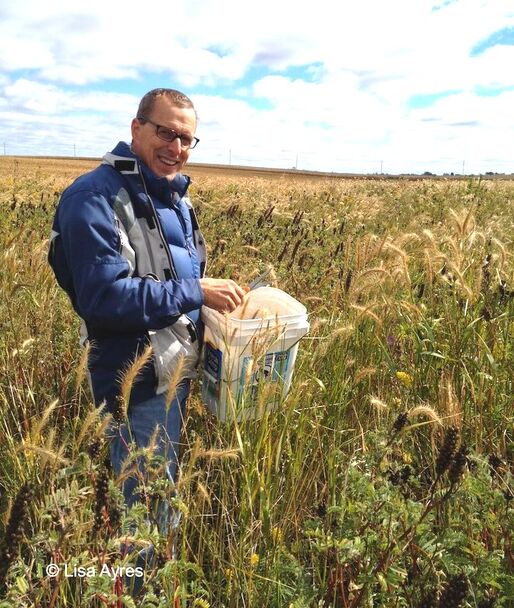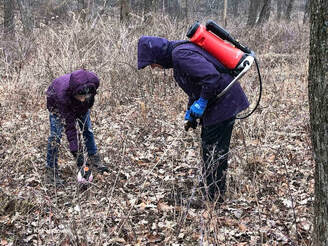|
By Kirk Hallowell and Mary Meier Nachusa Grasslands Volunteers Each year, volunteers commit over 8,000 hours of service to the restoration efforts of Nachusa Grasslands. Volunteers harvest seeds, keep invasive species at bay, assist in scientific research, tend prescribed fires, and perform a myriad of other tasks essential to the restoration process. Volunteer projects must be supported by equipment, herbicide, contract services, and other resources needed for success. Fortunately, the Illinois Clean Energy Community Foundation empowers volunteers by providing grant funds as a match to local dollars raised and labor donated. Community Stewardship Challenge Grant Program awards are used to purchase equipment, herbicide, and services necessary to make these volunteer activities possible. According to its website, “ The Illinois Clean Energy Community Foundation (ICECF) was established in December 1999 as an independent foundation with a $225 million endowment provided by Commonwealth Edison. Our mission is to improve energy efficiency, advance the development and use of renewable energy resources, and protect natural areas and wildlife habitat in communities all across Illinois.” (@illnoiscleanenergycommunityfoundation) The Illinois Community Foundation will award Friends of Nachusa Grasslands a grant of up to $30,000 if we fulfill requirements under several categories between May 1, 2023, and April 30, 2024:
Under the leadership of project coordinator, Kirk Hallowell, Friends has chosen two sites at which to focus volunteer hours and grant resources for their current stewardship project: Nachusa’s Big Jump Unit and the Holland Savanna Unit. Both areas are infested with invasive shrubs, including autumn olive (Elaeagnus umbellata) and amur honeysuckle (Lonicera maackii), two of the most tenacious foes that Nachusa’s volunteers battle. On its "Where We Work" web page, The Nature Conservancy explains, “Autumn olive is a problem because it outcompetes and displaces native plants. It does this by shading them out and by changing the chemistry of the soil around it, a process called allelopathy. Loss of native vegetation can have cascading effects throughout an ecosystem, and invasive species are one of the major drivers for a loss of biodiversity.” According to a Friends of Nachusa Grasslands blog post by Scientific Research Grant recipient Kaleb Baker, “Amur honeysuckle is an invasive shrub that flourishes along forest edges and in open woodlands such as those at Nachusa Grasslands. Amur honeysuckle shades out native flora with its early leaf-out and prolonged leaf retention, and when left uncontrolled, it can produce a near monoculture, threatening biodiversity.” Some of the ICECF funds already awarded have been invested in herbicide effective in eradicating autumn olive and amur honeysuckle. Volunteers treat the plants using backpacks and handheld sprayers. The next facet of the Big Jump project is to cut down and stack hundreds of non-native trees to make room for prairie restoration. This task that requires heavy equipment owned and operated by an external tree service contractor. ICECF grant funds will also be used to pay for the machinery and professional tree fellers. Kirk, who also serves as steward of the Holland Unit, offered, “It is exciting to know that the efforts of our volunteers empowered by the ICECF grant resources will make a lasting impact on our efforts to control amur honeysuckle in the Holland Savanna.” An additional challenge for the Holland Unit is that the parcel is dominated by cool weather grasses, including rye and fescue, which are typically resistant to overseeding efforts to establish native prairie plantings. In the second half of the ICECF grant period, we will experiment with preparation methods using herbicide to loosen the grip of the dominant grasses and allow overseeding of native plants to take hold. During the fall months, volunteers also helped collect seeds from the preserve for enhancing our prairie plantings. Our long-term goal is to establish a diverse prairie planting on both the Big Jump and Holland Savanna sites providing for long-term weed management and suppression of non-native shrubs and trees. Ongoing stewardship efforts, including volunteer labor, herbicide application, and controlled burns, will gradually help integrate the target areas into the surrounding habitat. The Friends Social Media Team uses Facebook, Twitter/X, Instagram, and our website to promote volunteer opportunities. You can also follow Illinois Clean Energy Community Foundation’s Community Stewardship Challenge Grant Program on Facebook and Twitter/X to learn more about the Foundation. #CSgrantsIL #NAicecfdn How Can You Help Friends Earn the ICECF Stewardship Grant?
Volunteer for a Thursday or Saturday brush clearing workday — check SignUpGenius for the schedule. Meet at Nachusa’s Headquarters Barn before 10 am and be ready to restore habitat. If you have any questions about the workdays, check the Friends of Nachusa Grasslands website.
0 Comments
|
Blog CoordinatorDee Hudson
I am a nature photographer, a freelance graphic designer, and steward at Nachusa's Thelma Carpenter Prairie. I have taken photos for Nachusa since 2012. EditorJames Higby
I have been a high school French teacher, registered piano technician, and librarian. In retirement I am a volunteer historian at Lee County Historical and Genealogical Society. Categories
All
Archives
January 2024
|
CONNECT WITH US |
|










 RSS Feed
RSS Feed